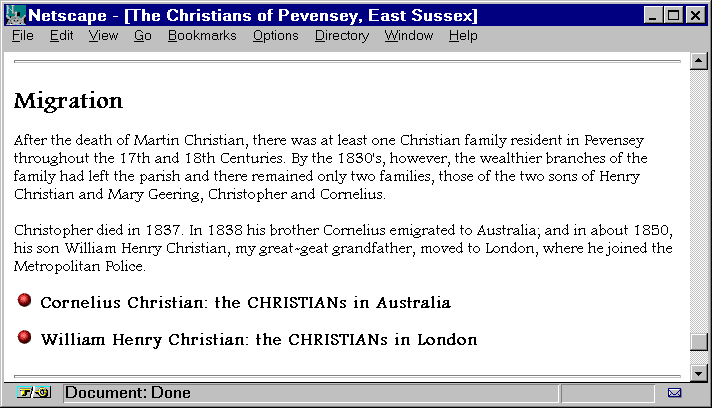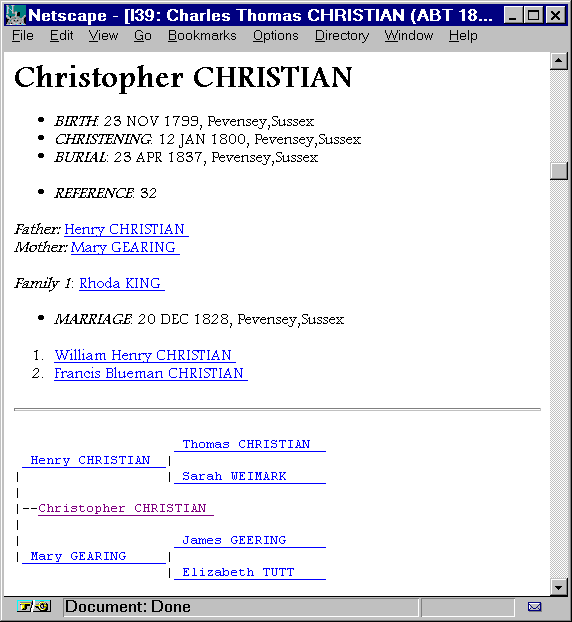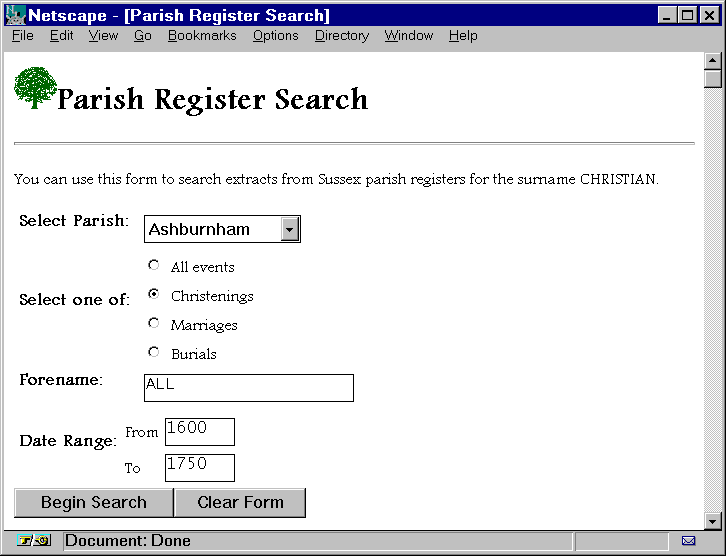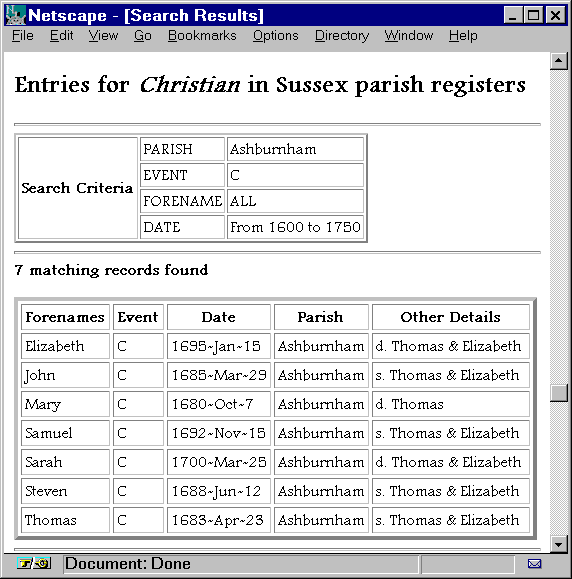
| CiG Home Page | This issue | This volume |
 |
Genealogical Publishing
by Peter Christian
[e-mail] -
[Web]
|
This article first appeared in Computers in Genealogy, Vol 5, No. 9 (March 1996)
© 1996 Society of Genealogists & the Author.
Recent articles in Computers in Genealogy have looked at the use of the Internet to find and retrieve information. But the article by Professor Randell and his associates in the last issue also observed that the World-Wide Web has "become a very effective instantaneous publishing medium, used by individuals as well as organisations". In this article, I would like to look at some of the reasons why the World-Wide Web is of use to genealogists in particular as a form of publishing.The Problems of Paper
In order to appreciate the possibilities of the World-Wide Web for genealogical publishing, it is worth considering first some of the shortcomings of the traditional methods of publishing one’s genealogical researches in print.Publication in print is perfectly suitable for publishing many types of archive and historical document, but while the word-processor and the cheap laser printer have made it much easier for the individual to produce quite polished publications for relatively little outlay, it is not entirely suitable for ongoing genealogical researches for a number of reasons.
Firstly, of course, such research will rarely be complete: there will always be new facts or materials or individuals to come to light; there will frequently be errors in some part of a pedigree or family history which will need later revision. But with small scale genealogical publications, printed in tens or hundreds, this is hardly practicable. And these very small numbers printed create a second problem: the publications can be very hard to get hold of and indeed their very existence is bound to escape the notice of some who would find them useful.
Finally, there is the difficult issue of presenting in a linear form large amounts of information, where each piece is connected with many others. Although much ingenuity has been expended in devising methods of presenting complex information on a 2-dimensional surface such as the printed page, there is still no single satisfactory answer to the question of how to organise a series of biographies of the individuals in a family history.
What is the World-Wide Web?
Before considering the Web might offer solutions to these problems, it is necessary to consider what it actually is. A good analogy for the World-Wide Web is a huge multi-volume encyclopaedia but without the physical problems and limitations of such a publication. Like a book, the Web consists of pages. In a book the page is simply a convenience for dividing up the linear flow of text (a scroll would do as well), whereas on the Web the page is a logical as well as physical unit of information — more like a single encyclopaedia entry that a page in a traditional book.It is often said that one advantage of the Web over a book is that the Web page can contain so-called links to other pages. But in fact printed books do contain links, in the form of footnotes or cross-references which point the reader to other pages or other publications [1] The advantage on the Web is the ease with which the links can be followed. In a book, you need to look at the note, copy down the reference and then go away and find the other book that is referred to (assuming the library has it). On the Web, you simply click on the link and the relevant page is retrieved and displayed on your monitor, whether it is stored locally or on a server on the other side of the world. Moreover, links on the World-Wide Web can even take you to the exact spot on the relevant page.
While the defenders of print make much of the unsuitability of electronic book for uses such as reading in the bath, the software used to read Web pages (a "browser") does provide distinct advantages over a traditional book. For in addition to allowing you to retrieve pages over the Internet, browsers have facilities for saving selected pages for later viewing or printing, for keeping a so-called "bookmark list" of useful pages you have come across, and for keeping a record of which pages you have already looked at. There is even software which will notify you when a selected page is updated.[2]
Current Information
But even if we disregard the general advantages or disadvantages of the electronic book versus print, the World-Wide Web does offer solutions to some of the problems of publication on paper mentioned above. In the first place, it is very easy to update incomplete or incorrect information on the Web, which means that the quality of information is likely to be better, and of course readers can be sure that they are always retrieving the most up-to-date information. And there is advantage for the publisher, too: because new material can easily be added, there is no need to find out everything before making some information available to others.To illustrate the benefits of this, let me give an example from my own Web pages on the Christians of East Sussex. Figure 1 shows the section at the foot of my main page on the Pevensey Christians. The two headings, for Cornelius and William Henry Christian, have no accompanying text, and for a very simple reason — I haven’t had time to write it. Now obviously, one could not publish a book with empty headings, but on the Web I can leave a place marker and fill in the details later. In fact I won’t even need to change this page — just prepare new pages for these two later branches of the family and add links to them from these headings. Indeed, if one of my Australian cousins, descended from Cornelius, were to put some pages on the Web, I would only need to link to his pages and not even create my own.

Figure 1
Of course, published on the Web, this information is not just more up-to-date and more easily modified than a printed family history would be, it is also instantly available to anyone with Internet access. Admittedly, this is, at present, only a small part of the community of genealogists, but as the Internet becomes an everyday facility, it may well be that the days of the small pamphlet are numbered.
Linking Individuals
The advantages of being able to free linking individual pages rather than having them in a fixed order are already considerable when considering the presentation of the diverse material of family history, but to a genealogist, this kind of linking will also call to mind the links between individuals in a family tree. Because creating links on the Web is very straightforward, it is relatively simple to publish information about individual ancestors along with links to their kin.Figure 2 shows part of a large page with family trees, in this case the section on Christopher Christian of Pevensey. Although this page shows only part of the tree, the (underlined) hypertext links allow the reader to move quickly to the information on his wife, children, or ancestors. For example, by clicking on the name "Thomas Christian" in the tree, the reader can move to the section of the tree for his grandfather.
What is even more impressive about these trees is that they required almost no work on my part — they were created automatically from a GEDCOM file in a few minutes.[3] At any time, I can create a revised version of these family trees as my database is extended or corrections made.

Figure 2
Beyond the Printed Page
So far I have looked only at how the Web can solve the existing problems of the printed family history, but in fact the Web offers additional features which are not even associated with print publishing: multimedia and interactivity.A Web page can contain not only text and graphics, but also links to audio and video files, which can be played on a computer with the appropriate hardware and software. One can therefore publish a family history with archives of oral history, for example, as easily as we currently include written documents.
At its simplest level, Web pages are interactive in that they can allow the reader to e-mail the author simply by clicking on an appropriate "hot spot" on the page. But Web pages can have also have, for example, search facilities. Software is available for indexing a group of Web pages, and it is also possible to write "scripts" (in reality small computer programs) to carry out other activities such as maintaining a "guest book" with readers’ comments or providing advanced searches of document or data collections.
One example of this can be seen in the Home Page of the Northern Ireland FHS, which has a searchable directory of members’ interests. On my own genealogical pages, I have a searchable database of the Sussex parish register extracts on which my reconstruction of Christian family history is based. Figure 3 shows the screen (called a "form") which you fill in with the details of the search (here all christenings in Ashburnham, between 1600 and 1750), while Figure 4 shows the page which is automatically generated with the results of this search. Again, it is a simple matter to add new parishes as I make further extracts.

Figure 3

Figure 4
It is not difficult to see the advantages of this type of searching facility compared to using a printed index (particularly if manually created), or even using the LDS CD-ROM, for it allows individual genealogists to provide easy access to their collected data. And although such facilities at the moment require some computing expertise, this is certain to change as the World-Wide Web becomes a more widespread form of publishing.[4]
Conclusion
Not only does the World-Wide Web offer solutions to some of the traditional problems of print and of genealogical publishing in particular, it can also offer new ways of presenting information and new methods of accessing it. And it is also important to note that most of this can be done with very little expense and without advanced computing skills — it can, if fact, be done by anyone. In the second part of this article, in the next issue of Computers in Genealogy, I will discuss how you actually set about creating a family history for the Web, how you "publish" it, and how you can use the Internet to publicise the existence of your genealogy pages.